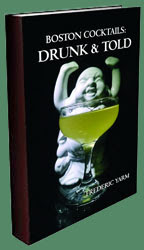Yesterday marked the conclusion of Thirst Boston, the successor to the Boston Cocktail Summit. While most of the events happened on Sunday and Monday, there was The Thing gala on Saturday night that I attended and a St. Germain detox event today that I sadly missed since I had a work shift. The scope of the event was not just cocktails and spirits, for beer, cider, and coffee were included in the mix. Unlike other cocktail events, I did not have cocktail fatigue at any point since there were so many options throughout the day via tasting booths and seminars. Without further ado, here are some of the random highlights of the weekend:

•
Best room opening: The D.T.O. room at The Thing. The Thing took place at the Harvard Club with the first bit held in a lobby looking area with a few drink stations including an amazing Bulleit Old Fashioned bar. Later, the doors entered to the voluminous main hall where music blared, drinks of all sorts were being mixed with props to the Remy Martin Cognac Sazerac. Finally, a third room was opened, the D.T.O. room. The Daiquiri Time Out is a phenomenon started in Boston by Andrew Deitz that pays tribute to political intrigue on
Chappaquiddick and a host of Boston celebrities were belting out these rummy libations.
•
Great way to start the morning: Irish Coffee. My first was served to me on Sunday by Jackson Cannon at the
Boston Cocktails: Past, Present, and Future talk and the next was by Tony Iamunno on Monday at the Kilbeggan booth. When I woke up this morning, I was saddened that there wasn't one on the docket for the day.
•
Laybacks? Yeah, that just happened: When I wanted to find out where one of the talks' rooms was, I was coerced to do a Galliano layback first by Stephanie Melchert, the local Lucas Bols brand rep. A second one was at the Blender Bender where I risked brain freeze at the hands of contestant Sam Gabrielli. And the third was the most humorous with the surprisingly delicious Bols Yoghurt Liqueur except the pourer was a little uncoordinated and the end result was a bit like a bukkake scene.

•
Swagfest galore. I think the final count was 7 shirts, 3 hats, a pair of Glencairn whisky glasses, and a random assortment of keychains, stickers, pins, pens, bottle openers, and other fine stuff. Best shirts nods go to Amaro Sibilla (thanks Aphonik!), Newburyport Beer, and Appleton Estate Bartender's Brunch. Best hats go to the Kilbeggan Irish cap and the Drambuie Fedora.
•
One of the most touching moments: When I was waiting in the media line to get into the sold-out sherry talk, speaker Derek Brown came out and insisted that I be let in. And I am glad that I got to hear him and Jackson Cannon speak about this amazing wine.
•
Best costume: Charlotte Voisey as a robot. Not even sure what talk or event she was doing it for, but she was walking around for a while like that. I even saw photos of her jamming with the Appleton event's reggae band dressed like that... Runner up was John D. Gertsen,
time traveler, dressed up like a colonial fop serving punch. The times that I have asked him if there isn't a costume he wouldn't wear, the answer is always no. The first time I spoke to John was back in 2007 or so at LUPEC Chartreuse event at Green Street and John broke the Silent Order rules for he was dressed as a Carthusian Monk that night.

•
Best D.T.O.: Will Thompson pounding it from a pitcher at the
Rum: The World's Most Versatile Spirit talk. Also the award for the most aggressive tasting that began with a hefty pours of Smith & Cross, Bacardi, and rhum agricole and continued on with cocktails made with each of those spirits. The breakfast of champions drink was the El Dorado 12 Year and Smith & Cross two rum Old Fashioned.
•
Best product name: Atsby's Armadillo Cake. No, not a flavored vodka but an intriguing vermouth we tasted at the
Rethinking Vermouth: The Renaissance of Fortified Wine talk.
•
Worst drink of Thirst Boston: Sean Frederick's bathtub gin mixed with orange juice at the
How Prohibition Changed Spirits & Mixology Around the World. Phil Duff followed it up with the quote, "Can anyone remember the first time you had an Orange Blossom (the drink in question albeit usually with better gin)? It's a disappointing drink, and I've been married twice." The other Prohibition-themed quote was from Imbue's Neil Kopplin at the vermouth talk; he declared, "Prohibition did more damage to drinking in America than Phylloxera."

•
Random thing I wrote on Twitter stemming from a conversation about what people order in the bars we each work at, "Vodka (on the rocks or with club soda) is a vehicle for sad men and angry women." Not sure how it came about in terms of the talks or if it is what eventually led to Maureen Hautaniemi coming over to shush us. Oops, sorry about that Maureen (and the others at the talk)! See the rum talk description above for an explanation...
•
Blogger stigmatization: Jacob Briars asked the audience if there were any writers in the house. When I raised my hand, Maggie of Privateer Rum yelled out that I was an author. Jacob commented, "Oh, a published author... at least you're not a blogger."
•
Nothing says excess like a Fernet Branca afterparty following a day of drinking and the blender event.
•
Great Gertsenian truism: "If you know where everything lives and know how to smile, you'll be a great bartender."
•
Worst realization: While getting dressed for the Thing, I discovered how difficult it is to tie a bowtie. I have years to go before I achieve anything resembling the level of that rapscallion, Tyler Wang. I ended up punting and going with a regular necktie.





 Last Friday, I went to session 1 of
Last Friday, I went to session 1 of 





 The theme for this month's
The theme for this month's 
















 The 2017 collection of 855 drink recipes, bartender tributes, and essays on hospitality from CocktailVirgin's Frederic Yarm. Available at
The 2017 collection of 855 drink recipes, bartender tributes, and essays on hospitality from CocktailVirgin's Frederic Yarm. Available at  The 2012 collection of 505 drink recipes, techniques, and Boston bar recommendations from Frederic Yarm. Available at
The 2012 collection of 505 drink recipes, techniques, and Boston bar recommendations from Frederic Yarm. Available at 



